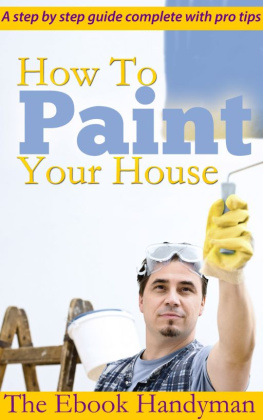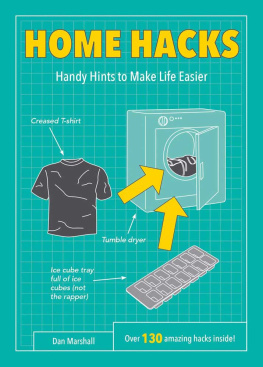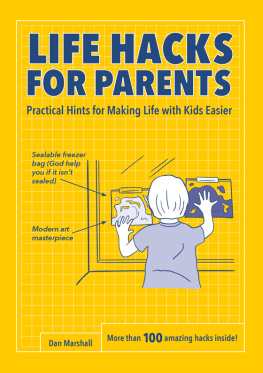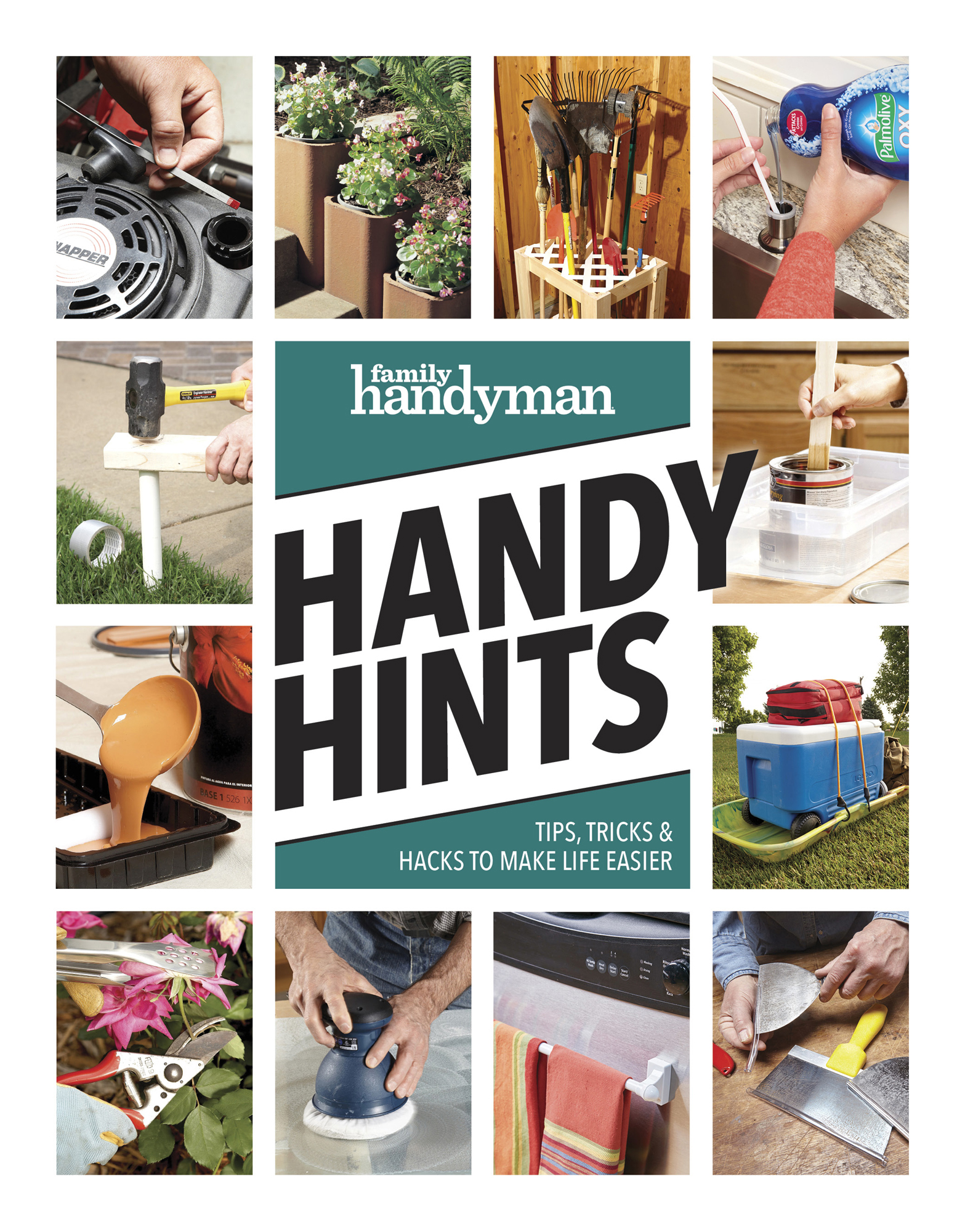CONTENTS
Guide
Family Handyman Handy Hints
Tips, Tricks & Hacks to Make Life Easier
Text, photography and illustrations for Family Handyman Handy Hints are based on articles previously published in Family Handyman magazine (2915 Commers Dr., Suite 700, Eagan, MN 55121, familyhandyman.com). For information on advertising in Family Handyman magazine, call 646-518-4215.
Family Handyman Handy Hints is published by Home Service Publications, Inc., a subsidiary of Trusted Media Brands, Inc. 2021. All rights reserved. This volume may not be reproduced in whole or in part without written permission from the publisher. Family Handyman is a registered trademark of Trusted Media Brands, Inc.
PHOTOGRAPHY CREDITS
Images: Dave Early
Getty Images: Chapter openers/hexagon pattern carduus
Shutterstock: Natali_Mis
All other photographs by Jim Erickson, Tom Fenenga, Mike Krivit, Will Leighton, Ramon Moreno and Bill Zuehlke
Hardcover ISBN: 978-1-62145-776-3
Paperback ISBN: 978-1-62145-777-0
ePub ISBN: 978-1-62145-778-7
Component number: 119100104H
LOCC: 2021938423
A NOTE TO OUR READERS
All do-it-yourself activities involve a degree of risk. Skills, materials, tools and site conditions vary widely. Although the editors have made every effort to ensure accuracy, the reader remains responsible for the selection and use of tools, materials and methods. Always obey local codes and laws, follow manufacturer instructions and observe safety precautions.
SAFETY FIRSTALWAYS!
Tackling home improvement projects and repairs can be endlessly rewarding. But as most of us know, with the rewards come risks. DIYers use chain saws, climb ladders, and tear into walls that can contain big and hazardous surprises.
The good news is that armed with the right knowledge, tools and procedures, homeowners can minimize risk. As you go about your projects and repairs, stay alert for these hazards:
ALUMINUM WIRING
Aluminum wiring, installed in about 7 million homes between 1965 and 1973, requires special techniques and materials to make safe connections. This wiring is dull gray, not the dull orange characteristic of copper. Hire a licensed electrician certified to work with it. For more information, go to cpsc.gov and search for aluminum wiring.
SPONTANEOUS COMBUSTION
Rags saturated with oil finishes like Danish oil and linseed oil, and oil-based paints and stains can spontaneously combust if left bunched up. Always dry them outdoors, spread out loosely. When the oil has thoroughly dried, you can safely throw them in the trash.
VISION AND HEARING PROTECTION
Safety glasses or goggles should be worn whenever youre working on DIY projects that involve chemicals, dust, and anything that could shatter or chip off and hit your eye. Sounds louder than 80 decibels (dB) are considered potentially dangerous. Sound levels from a lawn mower can be 90 dB, and shop tools and chain saws can be 90 to 100 dB.
LEAD PAINT
If your home was built before 1979, it may contain lead paint, which is a serious health hazard, especially for children ages 6 and under. Take precautions when you scrape or remove it. Contact your public health department for detailed safety information or call 800-424-LEAD (5323) to receive an information pamphlet. Or visit epa.gov/lead.
BURIED UTILITIES
A few days before you dig in your yard, have your underground water, gas and electrical lines marked. Just call 811 or go to call811.com.
SMOKE AND CARBON MONOXIDE (CO) ALARMS
The risk of dying in reported home structure fires is cut in half in homes with working smoke alarms. Test your smoke alarms every month, replace batteries as necessary and replace units that are more than 10 years old. As you make your home more energy-efficient and airtight, existing ducts and chimneys cant always successfully vent combustion gases, including potentially deadly carbon monoxide (CO). Install a UL-listed CO detector, and test your CO and smoke alarms at the same time.
FIVE-GALLON BUCKETS AND WINDOW COVERING CORDS
Anywhere from 10 to 40 children a year drown in 5-gallon buckets, according to the U.S. Consumer Products Safety Commission. Always store them upside down and store those containing liquid with the covers securely snapped.
According to Parents for Window Blind Safety, hundreds of children in the United States are injured every year after becoming entangled in looped window treatment cords. For more information, visit pfwbs.org.
WORKING UP HIGH
If you have to get up on your roof to do a repair or installation, always install roof brackets and wear a roof harness.
ASBESTOS
Texture sprayed on ceilings before 1978, adhesives and tiles for vinyl and asphalt floors before 1980, and vermiculite insulation (with gray granules) all may contain asbestos. Other building materials made between 1940 and 1980 could also contain asbestos. If you suspect that materials youre removing or working around contain asbestos, contact your health department or visit epa.gov/asbestos for information.
FOR ADDITIONAL INFORMATION ABOUT HOME SAFETY, VISIT HOMESAFETYCOUNCIL.ORG. THIS SITE OFFERS HELPFUL INFORMATION ABOUT DOZENS OF HOME SAFETY ISSUES.
CHAPTER 1
CLEANING
CLEANING AROUND YOUR HOME
No-Mess Refills for Sink Soap
Crawling under a kitchen sink to refill the soap dispenser is a hassle. You can try filling it from above, but when you do, the soap can form an air-lock bubble and overflow, creating a mess. Try inserting a drinking straw in the bottle to relieve bubble block. Now when you refill the dispenser, the air will escape through the straw and the soap will stay where it belongs.
MAGIC POULTICE FOR OIL-STAINED GROUT
If your tiled kitchen countertops and floor look terrible because of grease stains in the grout, and you think youve tried everything to get them out, try this two-step solution. First, make a thick paste of baking soda and water, and spoon it over the oil stains. Tape plastic over it and let it sit for 24 hours. Then make slits in the plastic and let the paste dry until theres no more moisture left (another 24 hours). Remove the plastic, sweep away the baking soda and voilclean grout!
SPARKLING DISHWASHER
Once a month or so, add a cup of vinegar to your empty dishwasher and let it run a full cycle. Your kitchen may smell a bit like a pickle jar for a few hours, but hard-water lime buildup will be rinsed away, making your spray arm and other dishwasher parts work flawlessly.













